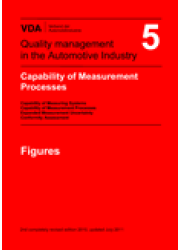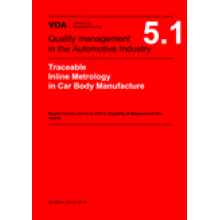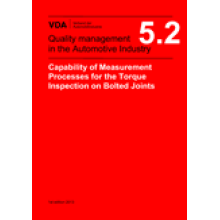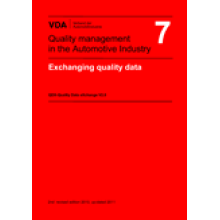VDA 5 Capability of Measurement Processes Capability of Measuring Systems 2nd completely revised edition 2010, updated July 2011
Quantity:
-
Add to Compare
The procedures described in this document are based on the ISO/IEC Guide 98-3 (Guide to the expression of uncertainty in measurement) (GUM) [22] and on ISO/TS 14253 (Inspection by measurement of work pieces and measuring equipment, Part 1: Decision rules for proving conformance or non-conformance with specifications) [13].
VDA Volume 5 also contains the well-established and widely used procedures of the MSA manual [1] that are used in order to evaluate and accept measuring equipment. It provides some information about the validation of measurement software as well.
In order to ensure the functionality of technical systems, single parts and assemblies have to keep specified tolerances. The following aspects must be considered when determining the necessary tolerances in the construction process:
-
The functionality of the product must be ensured.
-
Single parts and assemblies must be produced in a way that they can be assembled easily.
-
For economic reasons, the tolerances should be as wide as possible, but for functionality reasons, it should be as narrow as necessary.
-
The expanded measurement uncertainty must be considered in statistical tolerancing.
Due to the measurement uncertainty, the range around the specification limits does not allow for a reliable statement about conformance or non-conformance with specified tolerances. This might lead to an incorrect evaluation of measurement results. For this reason, it is important to consider the uncertainty of the measuring system and the measurement process as early as in the planning phase
Contents
|
1 |
Standards and Guidelines |
|
2 |
Benefits and Field of Application |
|
3 |
Terms and Definitions |
|
3.1 |
General Terms and Definitions |
|
3.2 |
Proof of Conformance or Non-conformance with Tolerances according to ISO/TS 14253 [13] |
|
4 |
General Procedure for Establishing the Capability of Measurement Processes |
|
4.1 |
Influences Causing the Uncertainty of Measurement Results |
|
4.2 |
General Information |
|
4.3 |
Specific Approaches |
|
4.3.1 |
Measurement Errors |
|
4.3.2 |
Long-term Analysis of Measurement Process Capability |
|
4.3.3 |
Reproducibility of Identical Measuring Systems |
|
4.4 |
Standard Uncertainties |
|
4.4.1 |
Type A Evaluation (Standard Deviation) |
|
4.4.2 |
Type A Evaluation (ANOVA) |
|
4.4.3 |
Type B Evaluation |
|
4.4.3.1 |
Type B Evaluation: Expanded Measurement Uncertainty UMP Known |
|
4.4.3.2 |
Type B Evaluation: Expanded Measurement Uncertainty UMP Unknown |
|
4.5 |
Combined Standard Uncertainty |
|
4.6 |
Expanded Measurement Uncertainty |
|
4.7 |
Calculation of Capability Ratios |
|
4.8 |
Minimum Possible Tolerance for Measuring Systems / Measurement Processes |
|
4.9 |
Uncertainty Budget |
|
4.10 |
Capability of the Measurement and Production Processes |
|
4.11 |
Dealing with Not Capable Measuring Systems / Measurement Processes |
|
5 |
Measurement Process Capability Analysis |
|
5.1 |
Basic Principles |
|
5.2 |
Capability Analysis of a Measuring System |
|
5.2.1 |
Resolution of the Measuring System |
|
5.2.2 |
Repeatability, Systematic Measurement Error, Linearity |
|
5.2.2.1 |
Estimating the Systematic Measurement Error and Repeatability according to the “Type 1 Study” |
|
5.2.2.2 |
Linearity Analysis with Correction on the Measuring Instrument |
|
5.3 |
Measurement Process Capability Analysis |
|
5.3.1 |
Example for Determining the Uncertainty Components of the Measurement Process |
|
6 |
Ongoing Review of the Measurement Process Capability |
|
6.1 |
General Review of the Measurement Stability |
|
6.2 |
Correcting the Regression Function |
|
7 |
Practical Guidance to Determining Typical Standard Uncertainties |
|
7.1 |
Overview of Typical Measurement Process Models |
|
8 |
Special Measurement Processes |
|
8.1 |
Measurement Process with Small Tolerances |
|
8.2 |
Classification |
|
8.3 |
Validation of Measurement Software |
|
9 |
Capability Analysis of Attribute Measurement Processes |
|
9.1 |
Introduction |
|
9.2 |
Capability Calculations without Using Reference Values |
|
9.3 |
Capability Calculations Using Reference Values |
|
9.3.1 |
Calculation of the Uncertainty Range |
|
9.3.2 |
Ongoing Review |
Write a review
Your Name:Your Review: Note: HTML is not translated!
Rating: Bad Good
Enter the code in the box below:
Copyright © 2014 Engineering Standards Bureau. All Rights Reserved.
Developed By Zoom Into Web






